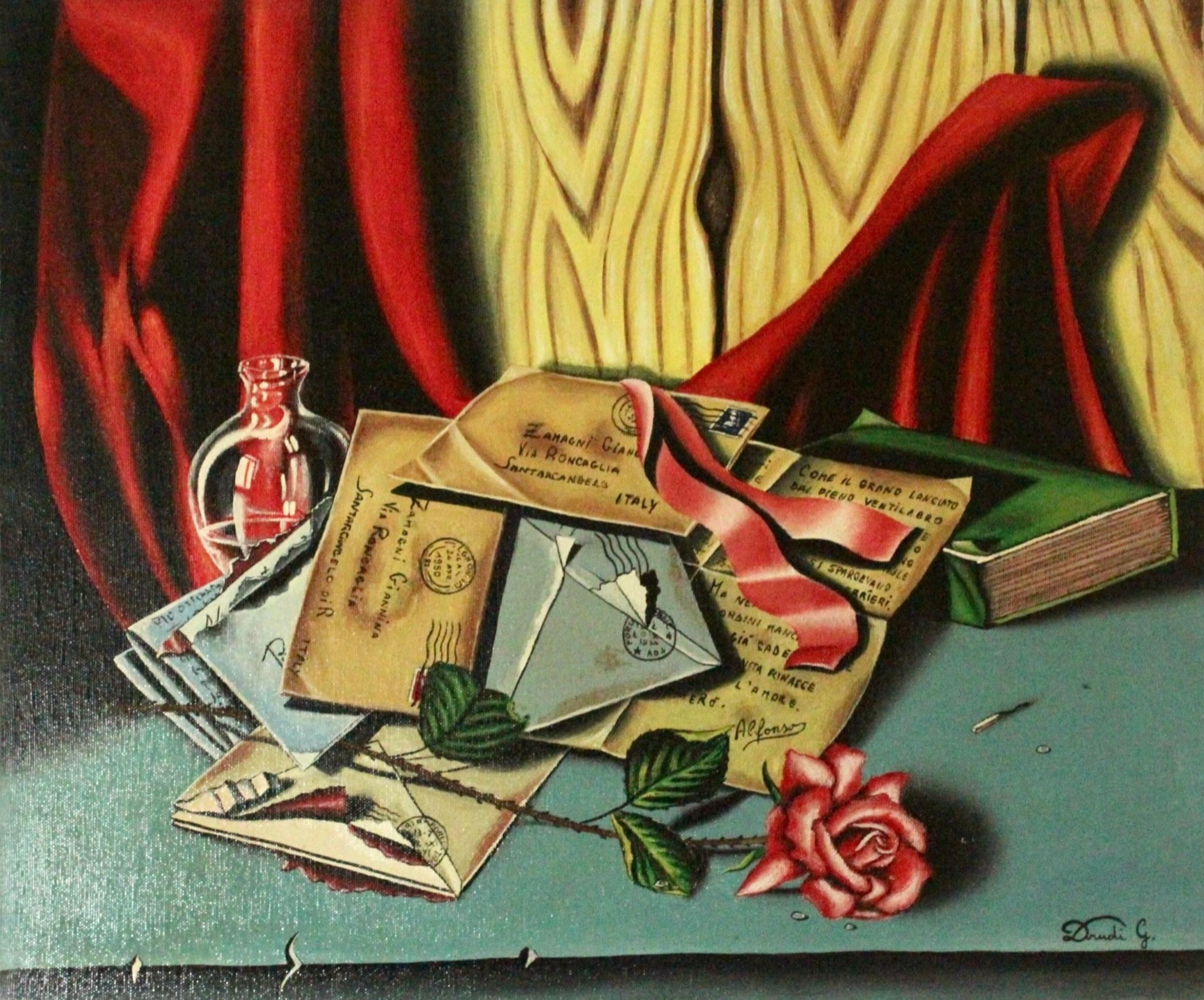LETTERS
1977, 50x60cm, Glossy oil on canvas

A still life with beautiful colors, featuring love letters, a book, a rose, and a small vase with water for the rose. Everything speaks of a man in love with her. The two lovers actually existed.
The work “Letters,” created in 1977 using glossy oil on canvas, is an evocative still life that encapsulates a profound love story. Each element of the composition seems to whisper the presence of an intense and lived experience, as if the artist wanted to imprint on the canvas not only images but also emotions and memories.
Composition and meaning:
At the center of the scene, we find a disorderly yet evocative group of letters, some open, others still sealed, a sign of intense correspondence between two real lovers. The visible postmarks and addresses add a touch of authenticity and testify to the sentimental value of these writings. Among the letters, a red ribbon stands out, a symbol of passion and deep connection, which delicately wraps around them. Next to the letters is a green book, perhaps a witness to shared moments or to the poems that nourished the love between the two protagonists. On the table, a freshly picked red rose, with its stem still fresh and green leaves, represents the beauty of love, but also its fragility. The almost transparent water vase, in its pictorial rendering, is there to keep the rose alive, a clear reference to the need to nurture feelings to make them last over time.
Pictorial elements and atmosphere:
The use of color is particularly significant in this work. The background alternates between warm and cold tones: on one side, the red curtain falling softly, creating a contrast with the light wood; on the other, the blue surface of the table, which adds a note of tranquility and nostalgia. The deep shadows and play of light give three-dimensionality to the objects, increasing the sense of intimacy and mystery. The attention to detail is extraordinary: the folds of the paper, the postmarks, the reflections of the glass, and even the small pin left on the table seem to suggest a story still alive, a love that, despite time, continues to exist through these objects.
Interpretation:
“Letters” is not just a representation of inanimate objects but a work that tells an authentic love story, made of waiting, passion, and memory. The artist does not limit himself to painting a still life but constructs a symbolic portrait of a lived feeling, leaving the viewer with the task of imagining who these lovers were and what their destiny might have been. This work, with its realistic details and emotional charge, represents the power of memory and love, demonstrating how even simple objects can hold extraordinary stories.

A still life with beautiful colors, featuring love letters, a book, a rose, and a small vase with water for the rose. Everything speaks of a man in love with her. The two lovers actually existed.
The work “Letters,” created in 1977 using glossy oil on canvas, is an evocative still life that encapsulates a profound love story. Each element of the composition seems to whisper the presence of an intense and lived experience, as if the artist wanted to imprint on the canvas not only images but also emotions and memories.
Composition and meaning:
At the center of the scene, we find a disorderly yet evocative group of letters, some open, others still sealed, a sign of intense correspondence between two real lovers. The visible postmarks and addresses add a touch of authenticity and testify to the sentimental value of these writings. Among the letters, a red ribbon stands out, a symbol of passion and deep connection, which delicately wraps around them. Next to the letters is a green book, perhaps a witness to shared moments or to the poems that nourished the love between the two protagonists. On the table, a freshly picked red rose, with its stem still fresh and green leaves, represents the beauty of love, but also its fragility. The almost transparent water vase, in its pictorial rendering, is there to keep the rose alive, a clear reference to the need to nurture feelings to make them last over time.
Pictorial elements and atmosphere:
The use of color is particularly significant in this work. The background alternates between warm and cold tones: on one side, the red curtain falling softly, creating a contrast with the light wood; on the other, the blue surface of the table, which adds a note of tranquility and nostalgia. The deep shadows and play of light give three-dimensionality to the objects, increasing the sense of intimacy and mystery. The attention to detail is extraordinary: the folds of the paper, the postmarks, the reflections of the glass, and even the small pin left on the table seem to suggest a story still alive, a love that, despite time, continues to exist through these objects.
Interpretation:
“Letters” is not just a representation of inanimate objects but a work that tells an authentic love story, made of waiting, passion, and memory. The artist does not limit himself to painting a still life but constructs a symbolic portrait of a lived feeling, leaving the viewer with the task of imagining who these lovers were and what their destiny might have been. This work, with its realistic details and emotional charge, represents the power of memory and love, demonstrating how even simple objects can hold extraordinary stories.